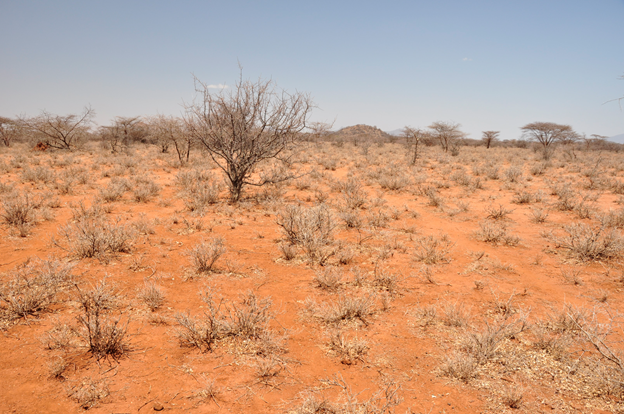 Earth & Space
Earth & Space
Arid lands transform abruptly as aridity increases
Ongoing climate change is expected to increase aridity conditions in worldwide, particularly in drylands, the vastest biome on Earth. However, whether aridification will cause smooth or abrupt changes in ecosystems is unknown. In a new study we analyzed natural aridity gradients globally to respond this question. We found three phases of drastic ecosystem change as aridity increases.

Climate change poses a concrete threat to arid ecosystems, in which water is limited (it rains less than 65% of what is evaporated). These dry ecosystems cover almost half of the terrestrial surface and are predicted to go through increased aridification, which endangers the plants and animals currently inhabiting therm. However, we currently do not know if this process will be gradual or abrupt. It is possible that a certain level of aridity can be a tipping-point, drastically affecting the ecosystem. Understanding these tipping-points, referred as thresholds, can better inform policies in relation to climate change. Furthermore, we need to characterize these, and how they affect the different components of the ecosystem, from the soil itself, to the plants, animal and microbes living in and on it.
We sampled 250 sites across the world, with increasing aridity conditions and use this data to ask: How will ecosystems change as aridity increase? In addition to our sampling, we used global databases of drylands from satellites and global maps. Together, our data includes information about plant cover, plant typology (whether vegetation is dominated by grasses, shrubs or trees), abundance and composition of soil microbial communities, soil fertility, and plant productivity, in more than 50,000 dryland ecosystems worldwide. We then analyzed the data to show how each of these attributes are affected by increasing aridity.
We found something really robust and surprising. All attributes examined responded nonlinearly to aridity increases, exhibiting an abrupt change at certain specific aridity levels. This means that aridity thresholds not only exist, but are also systematically affecting the entire ecosystem. Moreover, the aridity levels in which we found abrupt responses were consistently corresponded to three particular values. This means that as aridity increases, ecosystems transform drastically in three clear consecutive phases.
The first phase occurred at aridity levels similar to the humid Mediterranean. In this stage plant productivity started to decrease faster than at previous aridity levels. This likely means that the capacity of plants to photosynthesize is, from this aridity level on, starting to be hampered by water scarcity.
The second phase occurs at aridity values similar to the driest parts of Spain or Morocco. At this stage we observe an abrupt loss of soil fertility. Naturally, this has a strong effect on the entire ecosystem: from soil microbes to plants, because they all depend on soil fertility to function. In this stage, we can broadly say that aridity "broke the soil", making it unfertile, and plants adapted to this by becoming spiny, skeletal shrubs. This is a transition state towards becoming a desert. These ecosystems can still thrive, but they have been fatally injured.
The final phase occurs at aridity levels similar to dry Algeria. In this phase we see characteristics typical to deserts: an abrupt loss of plant species and a drastic decrease of vegetation. Plants must adapt their survival strategy, and need to use "disposable" leaves, that grow only on favorable rainy periods.
When we combine out data with current aridity prediction, we suggest that more than 20% of lands may cross one or several of these aridity thresholds by 2100. However, our predictions must be validated over time, as the future effects of climate change are not yet fully known and may alter our predictions. Our study highlights that arid ecosystems may undergo massive transformation resulting from climate warming. These changes can drastically change the lives of the people living in these areas, and our ability to predict and respond to these changes can be key to surviving them.
Original Article:
1. Berdugo M, Delgado-Baquerizo M, Soliveres S, et al. Global ecosystem thresholds driven by aridity. Science (80- ). 2020;367(6479):787-790.
Edited by:
Dr. Ayala Sela , Associate Editor
We thought you might like
Why some forests burn better than others
May 19, 2015 in Earth & Space | 4 min read by Elisa Dell'AglioThe silent battle of young corals against ocean acidification
Oct 19, 2016 in Earth & Space | 4 min read by Taryn FosterPoorly protected areas: human impacts are destroying nature’s safeguards
Nov 7, 2018 in Earth & Space | 4 min read by Kendall R. Jones , James E. M. WatsonFinding the novelty in nature
Oct 18, 2021 in Earth & Space | 3.5 min read by Timothy L. Staples , John M. PandolfiMore from Earth & Space
Discovery of the first radiation belt beyond the Solar System
Jan 27, 2025 in Earth & Space | 3.5 min read by Juan Bautista Climent OliverOne million (paper) satellites
Jan 24, 2025 in Earth & Space | 3 min read by Ewan Wright , Andrew FalleVolcanic Ash: A Nutrient Boost for Reef-Building Corals
Sep 18, 2024 in Earth & Space | 4 min read by Frank Förster , Tom SheldrakeAmmonia Energy: A Call for Environmental Awareness
Aug 29, 2024 in Earth & Space | 3.5 min read by Matteo Bertagni , Robert Socolow , Amilcare PorporatoLikely increase in coral thermal tolerance at a Pacific archipelago
Dec 29, 2023 in Earth & Space | 3 min read by Liam LachsEditor's picks
Trending now
Popular topics


